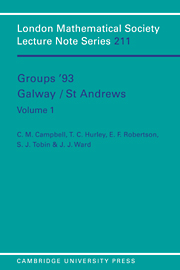Book contents
- Frontmatter
- Contents
- Preface
- Introduction
- Geometry, Steinberg representations and complexity
- The structure of metabelian finite groups
- Table algebras of extended Gagola-type and applications to finite group theory
- On the saturation of formations of finite groups
- Locally constructed formations of finite groups
- Reflections on virtually one-relator groups
- Rickard equivalences and block theory
- Computing the conjugacy classes of elements of a finite group
- Quotient categories of modules over group algebras
- Weak chain conditions for non-almost normal subgroups
- Computation of the character table of affine groups using Fischer matrices
- The lattice of compact representations of an infinite group
- Automorphisms of nilpotent and related groups
- Generation of orthogonal groups over finite fields
- The structure of certain Coxeter groups
- n-free groups and questions about universally free groups
- Classification of all generating pairs of two generator Fuchsian groups
- Parametric words and models of the elementary theory of non-abelian free groups
- The groups G(n, l) as fundamental groups of Seifert fibered homology spheres
- Lifting automorphisms: a survey
- (MI)-groups acting uniserially on a normal subgroup
- Revisiting a theorem of Higman
- Cohomological finiteness conditions
Generation of orthogonal groups over finite fields
Published online by Cambridge University Press: 02 March 2010
- Frontmatter
- Contents
- Preface
- Introduction
- Geometry, Steinberg representations and complexity
- The structure of metabelian finite groups
- Table algebras of extended Gagola-type and applications to finite group theory
- On the saturation of formations of finite groups
- Locally constructed formations of finite groups
- Reflections on virtually one-relator groups
- Rickard equivalences and block theory
- Computing the conjugacy classes of elements of a finite group
- Quotient categories of modules over group algebras
- Weak chain conditions for non-almost normal subgroups
- Computation of the character table of affine groups using Fischer matrices
- The lattice of compact representations of an infinite group
- Automorphisms of nilpotent and related groups
- Generation of orthogonal groups over finite fields
- The structure of certain Coxeter groups
- n-free groups and questions about universally free groups
- Classification of all generating pairs of two generator Fuchsian groups
- Parametric words and models of the elementary theory of non-abelian free groups
- The groups G(n, l) as fundamental groups of Seifert fibered homology spheres
- Lifting automorphisms: a survey
- (MI)-groups acting uniserially on a normal subgroup
- Revisiting a theorem of Higman
- Cohomological finiteness conditions
Summary
Results on two-element generation have been established for many important families of finite groups, encompassing all finite simple groups. For example, theorems of this type were proved for the finite non-abelian simple groups of Lie type, the symplectic groups over finite fields, and the sporadic simple groups by Steinberg [13], Stanek [12], and Aschbacher and Guralnick [2], respectively. A comprehensive survey of the status of results on this and related generation problems, some historical remarks, and an extensive list of references to the original literature can be found in a recent paper by DiMartino and Tamburini [6]. The purpose of the present paper is to report on some recent results on the generation of the finite orthogonal groups, including a proof that all such groups are generated by two elements. This proof is contained in joint work of Ishibashi and the author [10], except for several low-dimensional cases which are resolved in [4].
Background
The development of a general theory of the classical groups over arbitrary fields and division rings came to fruition in Dieudonné's fundamental volume La Géométrie des Groupes Classiques [5]. The definitive book of Hahn and O'Meara [7] provides a thorough modern treatment of this theory in the broader context in which the underlying ring of scalars is kept as general as possible.
- Type
- Chapter
- Information
- Groups '93 Galway/St Andrews , pp. 172 - 176Publisher: Cambridge University PressPrint publication year: 1995



